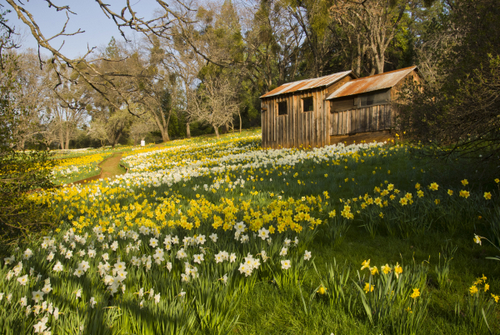
Two things coalesced recently in my mind into something quite new. The first was the age-old Daffodil Principle and the second a book recommendation from a client.
You might wonder what the combination of an old story and a new book have in common? Well, read on …
At this time of year daffodils are often on my mind – in the south of Scotland our daffodils often come out up to a month later than in the balmier south of England – but, perhaps thanks to our cooler temperatures – it seems to me that they also last longer. It’s one benefit of us still shivering in April I expect!

In the neighbouring Lake District, wild daffodils and bluebells make a magnificent gift from Mother Nature in April and May. Indeed Wordsworth wrote his famous “Host of golden daffodils” poem there and every year when I visit, I remember the Daffodil Principle.
What is the Daffodil Story?
It’s often told this way:
Several times my daughter had telephoned to say, “Mother, you must come to see the daffodils before they are over.”
I wanted to go, but it was a two-hour drive. “I will come next Tuesday,” I promised a little reluctantly.
Next Tuesday dawned cold and rainy. Still, I’d promised, so reluctantly I drove there. When I finally walked into Carolyn’s house I was welcomed by my grandchildren.
“Forget the daffodils, Carolyn. The road is invisible in these clouds and fog, and there is nothing in the world except you and these children that I want to see badly enough to drive another inch!”

My daughter smiled calmly and said, “We drive in this all the time, Mother.”
“Well, you won’t get me back on the road until it clears, and then I’m heading for home!”
“But first we’re going to see the daffodils. It’s just a few blocks,” Carolyn said. “I’ll drive. I’m used to this.”
Shortly, we turned onto a gravel road and I saw a small church. On the far side of the church, I saw a hand-lettered sign with an arrow that read, “Daffodil Garden.”
We got out of the car, each taking a child’s hand, and I followed Carolyn down the path. Then, as we turned a corner, I stopped and simply gasped.
Before me lay the most glorious sight.

It looked as though someone had taken a great vat of gold and poured it over the mountain and its surrounding slopes. The flowers were planted in majestic, swirling patterns, great ribbons and swaths of deep orange, creamy white, lemon yellow, salmon pink, and saffron and butter yellow. Each different coloured variety was planted in large groups so that it swirled and flowed like its own river with its own unique hue. There were five acres of flowers.
“Who did this?” I asked Carolyn.
“Just one woman,” Carolyn answered. “She lives on the property. That’s her home.”
Carolyn pointed to a well-kept small A-frame house, modestly sitting in the midst of all that glory. We walked up to the house. On the patio, we saw a poster.
“Answers to the Questions I Know You Are Asking,” was the headline.
1: 50,000 bulbs
2: One at a time, by one woman. Two hands, two feet, and one brain
3: Begun in 1958
For me, that moment was a life-changing experience.
I thought of this woman whom I had never met, who, years before, had begun, one bulb at a time, to bring her vision of beauty and joy to an obscure mountaintop.
Planting one bulb at a time, year after year, this unknown woman had forever changed the world in which she lived.
One day at a time, she had created something of extraordinary magnificence, beauty, and inspiration. The principle her daffodil garden taught is one of the greatest principles of achievement.
What can we learn from it?
We can learn to move toward our goals and desires one step at a time.
Don’t put it off. Don’t make excuses. Just take a step a day in the right direction.
Even just one baby step will help. We also NEED to learn to love the doing or ‘enjoy the journey’ and learn to use the advantages that time will give us to accumulate far more than we may currently believe is possible.
When we multiply tiny pieces of time with small increments of daily effort, we find we can accomplish magnificent things.
We can change almost anything.

“It makes me sad in a way,” I admitted to my daughter.
“What could I have accomplished if I’d thought of a wonderful goal thirty years ago and then just worked away at it … ‘one bulb at a time’ through those years?
Just think what I might have been able to achieve!”
My daughter summed up the message of the day in her usual direct way. “Start tomorrow,” she said. She was right.
It’s so pointless to think of the lost hours of yesterdays. The way to make this a lesson of celebration instead of a cause for regret is only to ask, “How can I put this to use today?”
Use the Daffodil Principle
Use the Daffodil Principle.
Stop waiting until … Whatever (you are using an excuse) happens.
We all have a million reasons – in fact, I might quote from Jack Canfield in a future post on the myriad of excuses we can give ourselves to put off making a change.
But for now …. Stop waiting for the time to be right for whatever it is that you want and just do something, however small, every day to get yourself closer to it.
And the connection with Atomic Habits?
Atomic Habits is a 2018 book by James Clear that a client recommended to me recently.
It’s really an excellent book, and he teaches us through his own powerful story in conjunction with some effective tips and exercises how we can put the Daffodil Principle into action in our own lives. Just by aiming for a 1% improvement. That might sound simple, but don’t underestimate it. Applying those tactics is powerful.
I recommend it to any of you who want to make a change of any kind in your own lives.
You can check it out here:
https://jamesclear.com/atomic-habits
The audio is well-narrated for those of you that prefer them – but do get the worksheets and bonuses from his website (link above) – you’ll need them with the audio ?

BTW
N.B. A quick clarification, there is now a 12-page book called the Daffodil Principle by Jaroldeen Edwards. However, that book was first published in 2004 and I have known stories of the Daffodil Garden since the mid-1980s. So that is not the ‘original’ of the story just a very cute illustrated adaptation of an age-old principle.